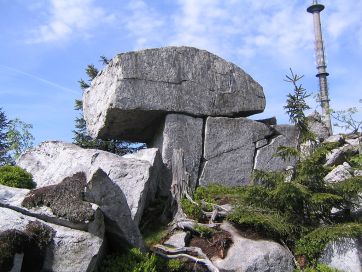Further Tales of the Wahles: Difference between revisions
Created page with "{{Sidebar|Ochsenkopf-Goethefelsen.jpg|Goethestein rock formation on Ochsenkopf mountain.|Further Tales of the Wahles|11|Bavaria|{{Coordinates|50.0306704, 11.8098900}}</br>{{Coordinates|50.0525,11.795833}}</br>{{Coordinates|50.058172,11.746677}}</br>{{Coordinates|50.038611,12.004722}}}} (Continued from Part II) Johann Heinrich Scherber, priest of Bischofsgrün, writes in his previously mentioned “Umsichten auf dem Ochsenkopf am Fichtelbe..." |
mNo edit summary |
||
| Line 1: | Line 1: | ||
{{Sidebar|Ochsenkopf-Goethefelsen.jpg|Goethestein rock formation on Ochsenkopf mountain.|Further Tales of the Wahles| | {{Sidebar|Ochsenkopf-Goethefelsen.jpg|Goethestein rock formation on Ochsenkopf mountain.|Further Tales of the Wahles|10|Bavaria|{{Coordinates|50.0306704, 11.8098900}}</br>{{Coordinates|50.0525,11.795833}}</br>{{Coordinates|50.058172,11.746677}}</br>{{Coordinates|50.038611,12.004722}}}} | ||
[[Excerpts from Wahles-Books|(Continued from Part II)]] | [[Excerpts from Wahles-Books|(Continued from Part II)]] | ||
Latest revision as of 03:04, 26 September 2025

|
| Geographic Coordinates: 50° 1' 50.41" N, 11° 48' 35.60" E 50° 3' 9.00" N, 11° 47' 45.00" E 50° 3' 29.42" N, 11° 44' 48.04" E 50° 2' 19.00" N, 12° 0' 17.00" E |
Johann Heinrich Scherber, priest of Bischofsgrün, writes in his previously mentioned “Umsichten auf dem Ochsenkopf am Fichtelberge”: “It is a known fact that a lot of foreign people have congregated on the Fichtelberg mountain since the 12th century who search for metals there. They were called in the Old German language: Wallends or shorter: Wahles, Walhaz, or Walloons. They wandered through every corner of the mountain all by themselves. Whenever one was spotted, he was either searching within the streams, hammering at rocks, or smelting at the fire. It was believed of them that they had a deeper understanding of stones, and, at the same time, knowledge of a secret art that allowed them to separate the precious contents from the base ore. But they carried the accumulated yield on their backs to their home country under the guise of simple trading with combs, mousetraps, and so forth. There, they played a prominent role in their place of origin thanks to the Fichtelbergian gold.
The Venetians are said to once have had their best workshop in the infamous Bergloch (at the Ochsenkopf mountain), and found gold in a cave on the side of that crevice which the workers in the workshop strove after and excavated. This cave is called the “Venetians’ Cave”.
Scherber furthermore remarks: “In every year there were examples of such adventuring wanderers from near and far”, and the publisher furthermore heard a tale of adventure from a farmer which a man from Bischofsgrün supposedly experienced together with a Walhaz.
This man wanted to go to the church in Bischofsgrün and arrived in town shortly before mass started. Then, a stranger approached him with the desire to be led onto the Ochsenkopf mountain. The farmer rejected this proposal with the comment that he didn’t want to miss mass, for soon the bells would start ringing for the gathering of the congregation. However, the Italian — for the farmer recognized him as such — smiled and said that if there was nothing else keeping him, he should just join him, for he would ensure that there would be plenty of time left for going to church. Then, the farmer accompanied the stranger on the way, though without any great confidence in the latter’s assurance. They climbed the high mountain, talked about assorted topics, and, finally, started on the way back. When they descended through the forest, the Walhaz asked his companion if he wanted to shoot a stag, even though he saw that the latter did not carry a rifle with him. And behold — in the same moment a mighty red deer stood next to the path between the trees. Then, the farmer realized that the Walhaz must be potent in secret arts. As the two of them came back to the village the bells started to ring and the farmer was still able to attend mass, even though the way up to the summit alone takes an hour to walk.
Known and claimed by several villages as their own, there is a legend of the Fichtelberg farmer who threw his knife into a whirlwind and, through this, pierced the eye of a Venetian, but who, nevertheless, was later lavished with favors by the latter. Likewise, a story is told about a man from Wülfersreuth that he was liberated from all debts and worries by a Walhaz he frequently gave hospitality in his home. For he remembered that the latter had told him to visit him in Venice and ask him for help if he ever experienced great destitution. The inexperienced forester did so and had reached the great, foreign city safely, but there he stood helpless and forlorn and stared at the proud palaces. Then he heard a voice call out from one of them: “Hans! Hans” — and a distinguished, richly dressed man hurried towards him. It was his former guest, the gold prospector in the Fichtel Mountains! Now the farmer received help. He lived days full of luxury and splendor and, finally, departed laden with riches.
Siegmund Wann, a native of Wunsiedel kept in fond memory, had brought “a born Walhaz woman” back home from Venice who was “highly experienced in alchemy and knew how to separate silver and gold from tin”. Wann attained “immeasurable wealth”, built a hospice in Wunsiedel in the year 1467, and supported it with a fantastic endowment. This man, who had such merit in his hometown, died in Eger.
Apart from the gold prospectors attracted by medieval traditions and the above-mentioned books, research of the modern age gives greater importance to the legends of the Wahles. Those strange figures are seen as a people who have been pushed back into the Fichtel Mountains who first panned gold and dug for ore. E. Fentsch (in Bavaria Vol. III p. 269)[al65, p. 269] points at the Wends and remarks that there could be an intriguing, if daring, conjecture. V. Baumer derives the name and ancestry of the Walloons from the Valli mentioned by Pliny (hist. Nat. VI. 11., compare Archiv für oberfränkische Geschichte und Alterthumskunde Volume II, Issue 3).[Bau42, p. 163] The Valli are a Slavic tribe whose original abode the old scholar of history and nature describes as follows: “a portis caucasiis per montes Gordyaeos” and remarks “indomitae gentes auri tantum metalla fodiunt.” During the advance of the Slavic peoples, the Valli likewise came into the Fichtel Mountains region and practiced their old trades there.
In the legends of the Upper Palatinate, the Venetians frequently have the size and appearance of the “little mountain men”, and Schönwerth comes to the following conclusion in his insightful examination: “Chuds and Romans were gradually displaced by the Germanic peoples, and in the lore the former (the tall people) and the latter (the mighty rulers of the world) gradually turned into giants, while the native Celts were turned into dwarves over the course of the centuries, similar to the Venetians and Wahles who came here in the Middle Ages to search for valuable metals. This is a clue that dwarves and Wahles belong to the same tribe and were divided by the invading Germanic peoples. They know from old times the secrets of wealth deriving from valuable metals that can be found in these lands and know the spots where these treasures can be gained.”
Schönwerth is of the opinion that the later familiarity of the Germanic people with the Slavic people weakened the memories of the Celts and reduced their forms of their appearance in the above-mentioned manner.
Source: Zapf - Der Sagenkreis des Fichtelgebirges, p. 100ff
 Sunken Castles, Evil Poodles: Commentaries on German folklore. Get the book for further context and explanatory commentary! |